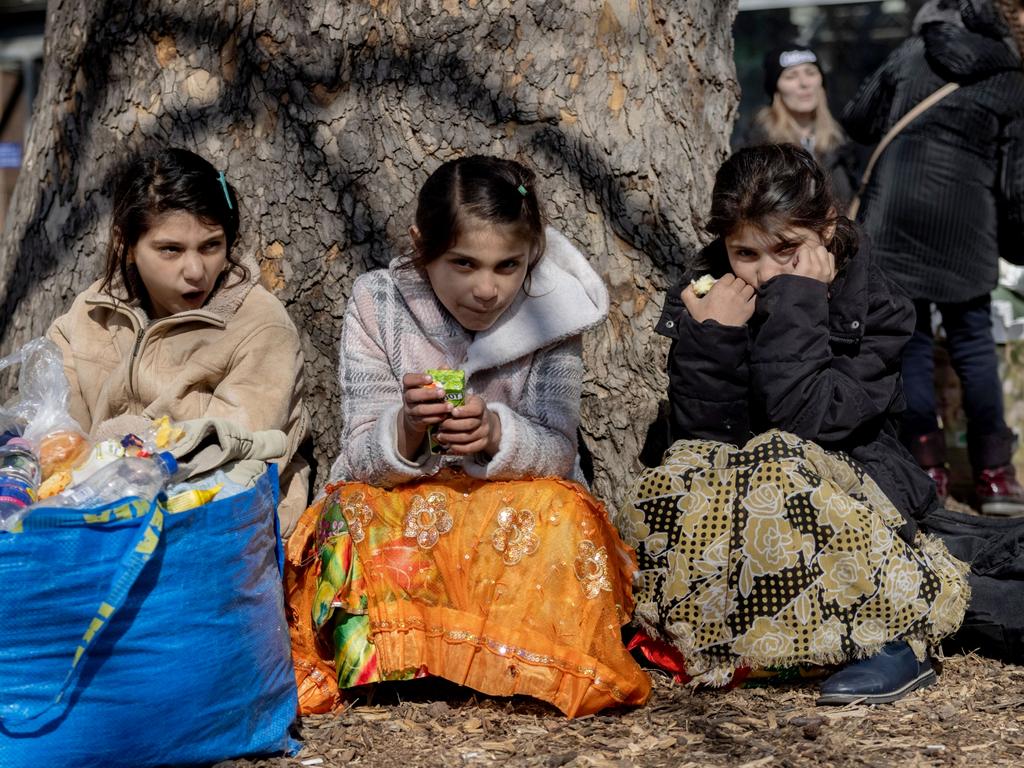Putin is another chapter in Russia’s blood-soaked story
Is brutality stamped into the DNA of Russian war-making and, if so, why? A fascinating new account links the war in Ukraine to the horrors of 1917-21.

He has raked over familiar ground in a new book on the bloody prelude to that epic, ideology-infused clash between Stalin’s Red Army and Hitler’s Wehrmacht. Russia: Revolution and Civil War 1917-1921 tells the gripping story of what spun out of the fall of the tsars and rise of the communist Bolsheviks in 1917 – a conflict of staggering scope that killed 12 million people, dragged in the armed forces of the West – including Australian volunteers – and set the scene for even greater slaughter when the world went to war in 1939.
It couldn’t be more timely, given the fraught situation in Ukraine. Vladimir Putin certainly fits the bill of any Russian or Soviet-era autocrat, given his monstrous disregard for human life, be it of a purported enemy or of his own soldiers. Think Nicholas II’s nihilistic arrogance or Lenin’s contemptuous view of “individuals as completely expendable objects”, to quote Russian revolutionary exile and writer Teffi, whose acerbic observations enliven Beevor’s book.

History echoes in the bitter fighting taking place today in the industrial heartland of Donbas in Ukraine’s southeast. The horse-mounted cavalry of the Reds and the anti-Bolshevik Whites wheeled there in the summer of 1919, slashing at each other with sabres on the same dusty flats that would be traversed by German panzers 23 years later as the doomed 6th Army advanced on Stalingrad. Then, as now, the northeastern city of Kharkiv was fought over again and again, like some spiteful giant’s plaything.
The savagery of the Russian civil war, which raged on until 1921, set a grim new benchmark for enmeshing the civilian population in the chaos of carnage of total war in the 20th century. As terrible as World War I was, it was mostly a soldier on soldier affair, waged on discrete battlefields. When the home front suffered physically, it was typically through shortages of food and medicine. The British navy’s blockade of imperial Germany’s limited sea approaches was particularly telling, contributing to starvation that stalked the urban poor as the armistice neared.
But as Beevor points out, the cruelty inflicted on civilians in the Russian civil war had not been experienced in Europe since the wars of religion in the 16th and 17th centuries. The Reds’ vicious Cheka set a blood-soaked standard for the thugs of the NKVD, SMERSH and later the KGB in the Soviet Union as well as the Nazi Gestapo.
They were matched atrocity for atrocity by the Whites, an unwieldy alliance of counter-revolutionaries, monarchists, non-Bolshevik socialists, democrats and Russian nationalists whose colour of choice came from the deposed Romanovs but who had little in common except their shared hatred of Lenin’s creed of communism.

Still, they were just as eager as the Reds to press-gang peasants at bayonet point or force them to turn over winter stocks to detested “food detachments”, guaranteeing a slow, lingering death when the snows came; prisoners of war – if taken – were routinely tortured or summarily executed by both sides in hideous ways.
A favoured technique was to bury the hapless captive to the neck, pack straw around the exposed head and set it alight, Beevor recounts.
“In a foretaste of the Nazi death squads in Russia less than a quarter of a century later, the Cheka’s prisoners were forced to undress completely so that their clothes could be reused,” he writes. “They were then made to kneel in cellars, or by open graves, so that their executioners only had to raise their heavy Mauser pistols with wooden stocks and shoot them in the back of the head. Some gloried in the bloodshed, while other executioners were driven mad by the relentless slaughter, just as Himmler discovered later with his own Einsatzgruppen.”
The question arises: Is brutality stamped into the DNA of Russian war-making and, if so, why? As David Aaronovitch observed in The Times recently, there are rational explanations for the atrocious conduct of Putin’s troops in Ukraine. One is they’re reacting to the depiction in Russia of Ukrainians as being mostly “Nazis”, unleashing the kind of hatred that sent a vengeful Red Army into a paroxysm of rape and murder in Berlin in 1945, masterfully documented by Beevor in his 2002 book. (The Kremlin accused him of undermining a “sacred element” of the country’s cherished World War II record, serving notice he would be liable to five years’ jail if he returned to Russia.)
Another school of thought holds that today’s Russian army is poorly NCOed, badly led, ill-disciplined and deeply resentful, its ranks swelled by unwilling conscripts who are desensitised well before they set foot on the battlefield by institutionalised mistreatment and violent hazing.
Yet, Aaronovitch wrote, “there is something so cynical about this brutality … it’s almost as if it comes from a place where such actions are seen as somehow inevitable, that always man will be wolf to man”. Beevor argues the answer lies in history, not a wrongheaded assumption that violence is ingrained in the national character of Russians.

“The trouble with Russia is its history is so violent, going all the way back to the Mongol invasion of the 13th century, and the idea that war has to be brutal and that conspicuous cruelty is a weapon of war,” he tells Inquirer. “This is what we are seeing now in Ukraine. Another feature is the cruelty of the Russian state to their own people. One only has to remember the way Stalin tried to cover up quite how many Russians died in the second world war, something like 27 million. He only admitted to seven million and, as Professor David Reynolds at Cambridge said, it sounded to him (Stalin) suitably heroic but not criminally homicidal.”
Beevor, 75, says it would be a mistake to view the war in Ukraine as an isolated event: like Putin, it is no anomaly. The interlinked chains of events that led to the Russian civil war and emanated from it show why.
Just as World War I helped beget the October 1917 revolution and in turn internecine conflict in Russia, the subsequent battle of ideology between the victorious Reds and Nazi Germany was given expression in the 1936-39 Spanish civil war (also documented by Beevor in a 2006 book) between Francisco Franco’s Nationalist rebels and the Soviet-backed Republicans they defeated with support from Hitler and Fascist Italy, and ultimately in World War II’s decisive theatre on the Eastern Front.

“For far too long we have made the mistake of talking about wars as a single entity when they are often a conglomeration of different conflicts, mixing national resentments, ethnic hatreds and class warfare,” the former British army officer writes in Russia.
“And when it comes to civil wars, there is also a clash of centralism against regionalism and authoritarianism against libertarianism. The idea of a purely ‘Russian’ civil war is another misleading simplification. It prompted one historian recently to describe it instead as ‘a world war condensed’.”
As for Putin, the former KGB spy who said the collapse of the Soviet Union in 1991 was the “greatest geopolitical catastrophe” of the 20th century, the irony abounds. The Russian dictator is closer to a latter-day tsar than a communist-style leader, Beevor insists. Look no further than the white hall of the Kremlin, where he likes to hold court at the far end of a ridiculously long table. The statues on show aren’t of Lenin, Stalin or other heroes of the revolution; they’re of long-dead Russian emperors. Then there’s Putin’s notorious Black Sea palace at Gelendzhik, dotted with the double-headed eagle insignia of the Romanovs.
“He’s a stinking snob,” Beevor says, chuckling. “Seriously, Putin is not planning to rebuild the Soviet Union as much as he longs to re-create the tsarist empire.”
Russia: Revolution and Civil War 1917-1921 by Antony Beevor, Hachette, 592pp, $55.







If there is a Russian way of making war, Antony Beevor is impeccably placed to describe it. The best-selling British author and knight of the realm delved deep into once-sealed communist military archives to flesh out his searing accounts of the battles for Stalingrad and Berlin in World War II, shedding fresh light on the brutality of warfare on the Eastern Front.